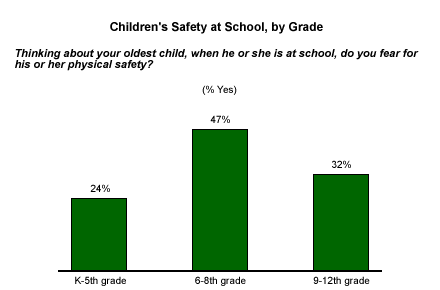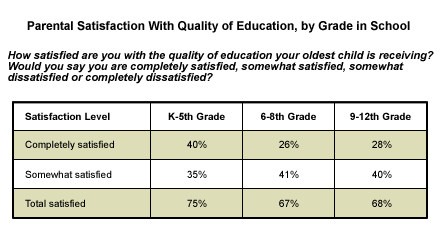First in a two-part series on the perceived gap between elementary and middle schools.
The goal of middle school, once called junior high school, is to create a necessary bridge between the elementary and high school experiences with a philosophy, approach, and program of its own. However, recent Gallup research suggests a gap between the perceptions of elementary and middle school parents about the safety and quality of education in their children's schools.
The Gap
According to aggregated data from the most recent Gallup Work and Education polls*, American parents whose oldest child is in middle school say that they are more concerned about the physical safety of their children at school than parents whose oldest child is in elementary or high school. The level of concern is 47% among parents whose oldest child is in middle school, compared to 32% among those whose oldest child attends high school, and just 24% of those whose eldest child is in elementary school. (See "Parents Concerned About School Safety" in Related Items.)

A similar gap exists with regard to perceptions of satisfaction with the quality of education the schools provide. While 40% of elementary school parents are completely satisfied with their child's quality of education, only 26% of middle school parents are completely satisfied. (High school parents are about as satisfied as middle school parents are, at 28% completely satisfied.)

Why is the gap between the perceptions of middle and elementary school parents (as well as those of middle and high school parents on the question of safety) so large? The answers may come from understanding middle school students, parents, and the schools themselves.
How Are Middle School Students Different?
Parents of 11- to 14-year-olds will attest that middle school teachers and principals have their hands full. Middle school students are undergoing great physical, intellectual, and social changes. Hormones are raging. Because children this age physically mature at different speeds, some middle school students look like they still belong in elementary school, while others look like they belong in high school.
Middle school students are struggling to develop a sense of identity. They want to be different from adults, but identical to the "in" peer group simultaneously. As a former teacher and assistant principal, I recall the fears of incoming middle school students. The trip to school often involves increased walking distance or a first-time bus ride. The increased size of the school creates persistent fears of getting lost, not being able to find classes or find and open lockers. Moving from class to class creates the potential for jostling in the halls and bullying by older students. Gym class and dressing in the locker room poses real and imagined anxieties for many students.
Other challenges, such as a more difficult academic workload and meeting the demands of a group of teachers rather than just one or a few, tend to increase the pressure on middle school students as the year goes on. Finding a peer group to fit into is a constant concern. As if all this is not enough, middle school is when most students are first exposed to the temptations of smoking, alcohol, drugs, and sex.
Middle School Parents
At the same time, the relationship between parents and schools changes as students enter the middle grades. These changes can result in a major disconnect in parental involvement between elementary and middle school. Students may no longer want a parent at school and actively discourage involvement. Similarly, parents may begin to "ease up," becoming less involved in the lives of their children as those children seek independence and become more self-sufficient. In some cases, mothers who are not already working outside the home may return to work during a child's middle school years.
The Structure of Middle Schools
The organizational structure of America's schools also contributes to the gap between elementary and middle school. Elementary schools tend toward smaller enrollments, in relatively small facilities. Students tend to know each other because they come from the same neighborhood areas. Middle schools, by contrast, tend to have higher enrollments with much larger facilities, and often serve more than one elementary school. In nearly all of these respects, middle schools resemble high schools more so than elementary schools.
All things considered, it is not surprising that middle school parents express greater concern for the safety and quality of education of their children than elementary school parents do. Next week's story will address the ways that America's schools can work to close that perceptual gap.
*Results are based on aggregated data from telephone interviews with 840 parents with children in kindergarten through 12th grade in Gallup's 1999-2002 Work and Education polls, all conducted in August. For results based on the total sample, one can say with 95% confidence that the maximum margin of sampling error is ±4%.